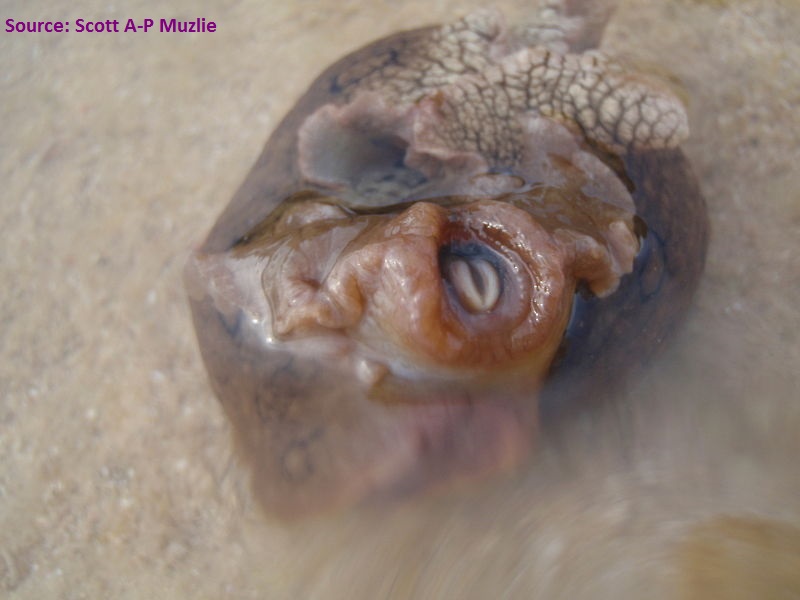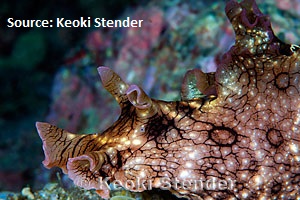
Form and Function
Aplysia dactylomela is
typically a pale yellow to green color although specimens with
different coloring schemes are not all that uncommon (Encyclopedia of Life 2008). The distinguishing characteristic of
A. dactylomela comes from
the ring-like irregular splotches on the dorsal portion of the its
body, netting it the common name of "spotted sea hare" (Encyclopedia of Life 2008). Suprisingly compared
to the size of terrestrial snails that most people are familar with,
A. dactylomela
typically grows to 15 or 16 centimeters as an adult with a
maximum size of 40 centimeters (Marine
Invertebrates of Bermuda 2008 ,
Encyclopedia of Life 2008). Moving on from
these basic distinguishing features of A. dactylomela, for
organizational purposes, the following paragraphs will divide the
organism into three sections—body plan and locomotion,
sensory organs and
neurology, and digestive system structure and options for food—to
more easily explain the form and function of the animal. Although it
could potentially belong within this page, please be aware that the
purple gland and the inking ability of A. dactylomela will be
covered in the "Interaction with Other Species" section so head over
to that portion of the website if it is your primary interest.
 Like the majority of other Opisthobranch mollusks, A. dactylomela
contains a thin, barely calcified, shell in the interior of its body
that might give some support but provides nowhere near the
protection of other mollusks like clams. Instead, A. dactylomela,
its relatives, and ancestors developed large flaps of skin that
attach near the foot and can fold over the mantle to protect the
gill and other organs previously defended by a shell (Sea Slug
Forum 2000). Some Opisthobranchs use the parapodia to swim gracefully
through the water, but since A. dactylomela's is relatively small in
comparison, it can only swim for brief periods at a time (Marine
Invertebrates of Bermuda 2008). Alternatively, the large muscular foot, located
along the entirety of its mantle, provides the majority of its
locomotion, unless prompted to swim by some stimuli like predation.
Compared to the rest of the organism's skin that has a leathery, smooth
texture, the foot feels rough and likely helps by providing traction
(Encyclopedia of Life 2008)(Sea Slug Forum
2000).
Like the majority of other Opisthobranch mollusks, A. dactylomela
contains a thin, barely calcified, shell in the interior of its body
that might give some support but provides nowhere near the
protection of other mollusks like clams. Instead, A. dactylomela,
its relatives, and ancestors developed large flaps of skin that
attach near the foot and can fold over the mantle to protect the
gill and other organs previously defended by a shell (Sea Slug
Forum 2000). Some Opisthobranchs use the parapodia to swim gracefully
through the water, but since A. dactylomela's is relatively small in
comparison, it can only swim for brief periods at a time (Marine
Invertebrates of Bermuda 2008). Alternatively, the large muscular foot, located
along the entirety of its mantle, provides the majority of its
locomotion, unless prompted to swim by some stimuli like predation.
Compared to the rest of the organism's skin that has a leathery, smooth
texture, the foot feels rough and likely helps by providing traction
(Encyclopedia of Life 2008)(Sea Slug Forum
2000).
The
term 'sea hare' comes from the non-scientific grouping of sea slugs
with tentacles that resemble rabbit's ears, thus making them look
like rabbits of the sea. What would be the rabbits ears is instead a
pair of sensory organs called rhinophores which are very similar in
function to a nose in that it allows the sea hare the ability to
smell food and pheromones from other A. dactylomela. Just below the
rhinophores on the head of the sea slug are the eye. While they are
far from being able to distinguish objects, they can see
some light. A. dactylomela is a nocturnal animal and these eyes help
detecting safe times for searching for food as well as when a predators might be nearby by the shadow it casts. On either
side the creatures mouth are the oral tentacles, and in combination
with the rhinophores allow the slug smell and taste(Sea
Slug Forum 2000).
Controlling all the organisms functions are multiple simple clusters
of nerves called ganglion which are sort of like an incredibly
simple brain
Aplysia
dactylomela is a herbivore that dines primarily on green and red
algae, but can also eat larger sea weeds as well. Using the array of
tentacles described above as a locator, Aplysia dactylomela pull
itself through the shallow water grass sea beds with its muscular
food.
 Once food is found found, A. dactylomela dines by using its jaws to clutch
the meal and radula to suck the food into its buccal cavity. From
there, the crop’s chitinous plates that act like a gizzard, helping
digest larger weeds and masses of algae (Encyclopedia of Life 2008).
Moving farther into the digestive system, food and other particles
enter the stomach and eventually either the intestines or caecum,
all of which have ciliated walls that complete a complicated sorting
of edibles from non-edibles (Sea Slug Forum
2000). One interesting aspect
of Aplysia dactylomela's diet is its influence on the coloring of
the organism and the ability to swim; a diet consisting mostly of
red algae can have the effect of coloring the slug a darker red
while a diet heavy in silicone can prevent the slug from being able
to float well and thus, swim (Marine
Invertebrates of Bermuda 2008).
Once food is found found, A. dactylomela dines by using its jaws to clutch
the meal and radula to suck the food into its buccal cavity. From
there, the crop’s chitinous plates that act like a gizzard, helping
digest larger weeds and masses of algae (Encyclopedia of Life 2008).
Moving farther into the digestive system, food and other particles
enter the stomach and eventually either the intestines or caecum,
all of which have ciliated walls that complete a complicated sorting
of edibles from non-edibles (Sea Slug Forum
2000). One interesting aspect
of Aplysia dactylomela's diet is its influence on the coloring of
the organism and the ability to swim; a diet consisting mostly of
red algae can have the effect of coloring the slug a darker red
while a diet heavy in silicone can prevent the slug from being able
to float well and thus, swim (Marine
Invertebrates of Bermuda 2008).
Up next: Learn more about the reproduction of A. dactylomela.
